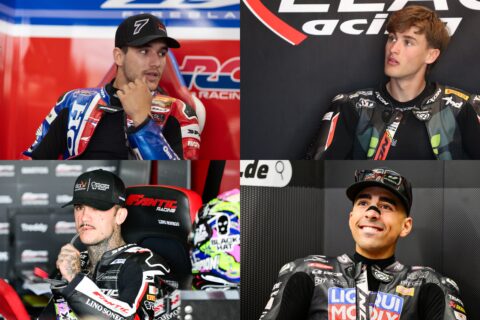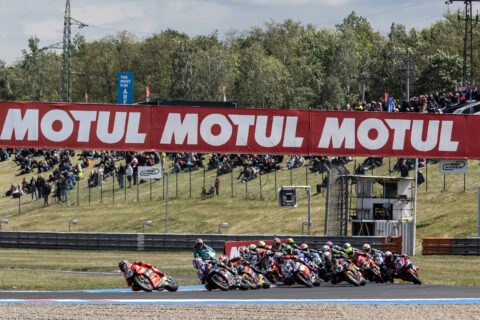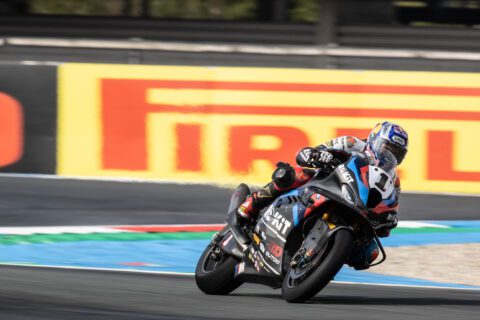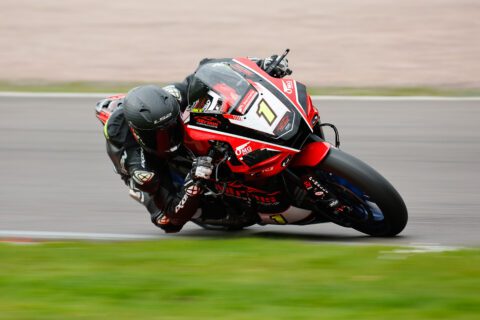Well, the descriptive answer to the title question is a simple “very”, but the numbers tell a more detailed story.
Francesco Bagnaia won Sunday’s 2024 MotoGP Qatar Grand Prix in 39 minutes and 34.869 seconds. That’s 14.012 seconds faster than the winning time of Fabio Di Giannantonio (to 21 laps) last year. (It’s important to note the 21 laps, because the ordinary distance for the Qatar Grand Prix is 22 laps, but Raul Fernandez’ bike problem on the grid on Sunday meant the start was delayed and the race distance reduced to 21 laps.)

It’s probable that, had Bagnaia not almost run into the back of Di Giannantonio with three laps to go in last year’s Grand Prix, he would have finished the 21st lap in almost the same 39 minutes and 48.881 seconds as Di Giannantonio last November. In any case, Bagnaia’s 2024 time marks an improvement of 0.587 per cent in winning times between the two years, and the aforementioned likely similarity between Bagnaia’s and Di Giannantonio’s race times last year means that Bagnaia has probably made about the same half-a-per-cent improvement over his own self of last November.
Several things have changed over the winter. Bagnaia is no doubt even more confident now than he was then, with the #1 plate still stuck to the front of his Desmosedici and with another two-year Ducati contract in his pocket. But also the Desmosedici has changed, with a more powerful engine and adjusted aerodynamics that have supposedly improved the bike’s braking capabilities, perhaps at the cost of some mid-corner turning. At the same time, the tyres from Michelin have changed: the construction and profile are both the same as last year, but the compound rubber is different - harder, and therefore more durable, but reportedly without a sacrifice in grip. All of these factors, in addition to the settling of the new track surface at the Lusail International Circuit, will have played a role in the lowering of the race time.
While there are some interesting numbers within the race itself, such as Marc Marquez’ deficit of only 3.429 seconds (0.144 per cent slower than Bagnaia over 21 laps) while riding a year-old Ducati, and Alex Marquez’ 15-second improvement over last year’s first 21 laps, it’s difficult to read too much into them.

Qatar is an odd race, which takes place at night, after little-to-no representative practice (this year’s only night practice was wet), and in the middle of the desert on a track which is completely flat. Lusail is as close to unique as it gets among modern MotoGP-eligible race tracks. It’s also the first race of the year, and so to make many inferences about the season as a whole from just those 21 laps under the Lusail lights would be somewhat ignorant of reality.
But we can look at what the race tells us about the evolution of MotoGP over the last 10 years or so, and particularly since the turn of the decade.

In 2015, Valentino Rossi won the Qatar Grand Prix. His time to 21 laps was 40 minutes and 40.365 seconds. He also set the fastest lap at 1:55.267.
That means that Bagnaia’s 2024 winning time of 39:34.869 marks an improvement of more than one minute over the last nine years. This equates to a 2.684 per cent improvement over the last race in Qatar of the Bridgestone era.

The first year of the Michelin era saw Jorge Lorenzo win, and his time to 21 laps was 40:32.629, and his fastest lap was a 1:54.927. Lorenzo’s 2016 winning time to lap 21 was 2.575 per cent slower than Bagnaia’s this year, but 0.317 per cent better than Rossi’s time to lap 21 in 2015, despite the introduction of the control Magneti Marelli ECU in 2016.
If you extrapolate the 0.317 per cent improvement between 2015 and 2016 over the nine years since Rossi won, you would get a 2.853 per cent improvement by 2024, which - obviously - is more than the improvement of Bagnaia’s time over Rossi’s.
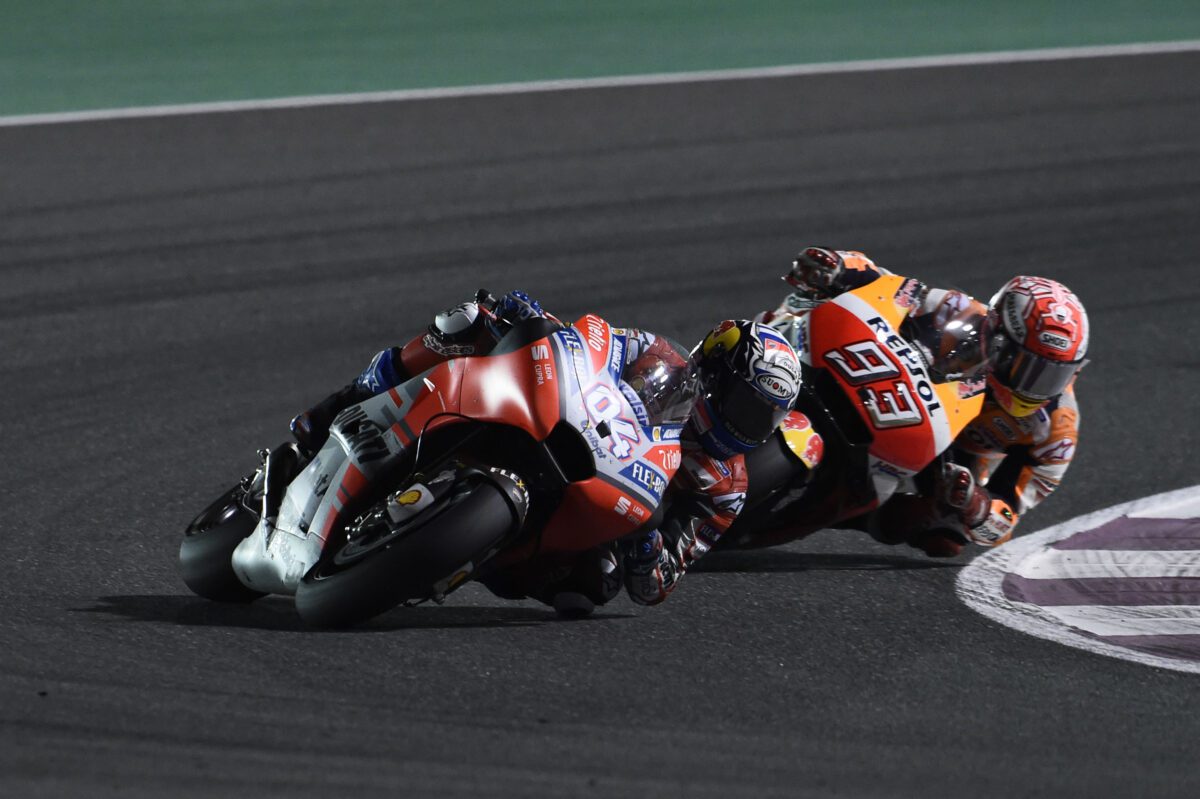
However, the path to Bagnaia’s time is not a steady improvement. There is actually a regression in 2018 and 2019 (we have to ignore 2017 because the race distance was shortened to 20 laps for rain delays). In 2018, Andrea Dovizioso won, and completed the 21st lap in 40:38.771 - more than six seconds slower than Lorenzo two years earlier. Dovizioso’s fastest lap, the fastest lap of the race, was also slower than Lorenzo’s at 1:55.242. The following year, 2019, a race which ended in an almost identical way to 2018, Dovizioso reached the end of lap 21 in 40:41.414 and his fastest lap was a 1:55.385 (Fabio Quartararo had the fastest lap of the 2019 race, but he did it while charging towards the back of the field after having to start from pit lane).
The reason for the temporal regression was likely about tyres, for the most part. Michelin came into 2016 with soft, high-grip rear tyres that especially riders like Jorge Lorenzo, who used a lot of mid-corner speed, were able to exploit. Then, Scott Redding had a tyre delamination during the pre-qualifying FP4 session at the 2016 Argentinian Grand Prix, and Michelin decided to introduce what was referred to at the time as a ‘safety tyre’, with a harder construction that reduced ultimate performance and, ultimately, shifted the balance towards riders who liked the rear to be more loose, like Marc Marquez and Andrea Dovizioso, who were able to exploit the low-grip rear tyre to turn.
What the harder construction also did was increase the amount the tyre slid both in acceleration and deceleration, which increased tyre wear and therefore placed an emphasis on tyre management for the riders. This was another area of expertise for Dovizioso who was able to manage races from the lead by effectively controlling the pace of the other riders in the front group.
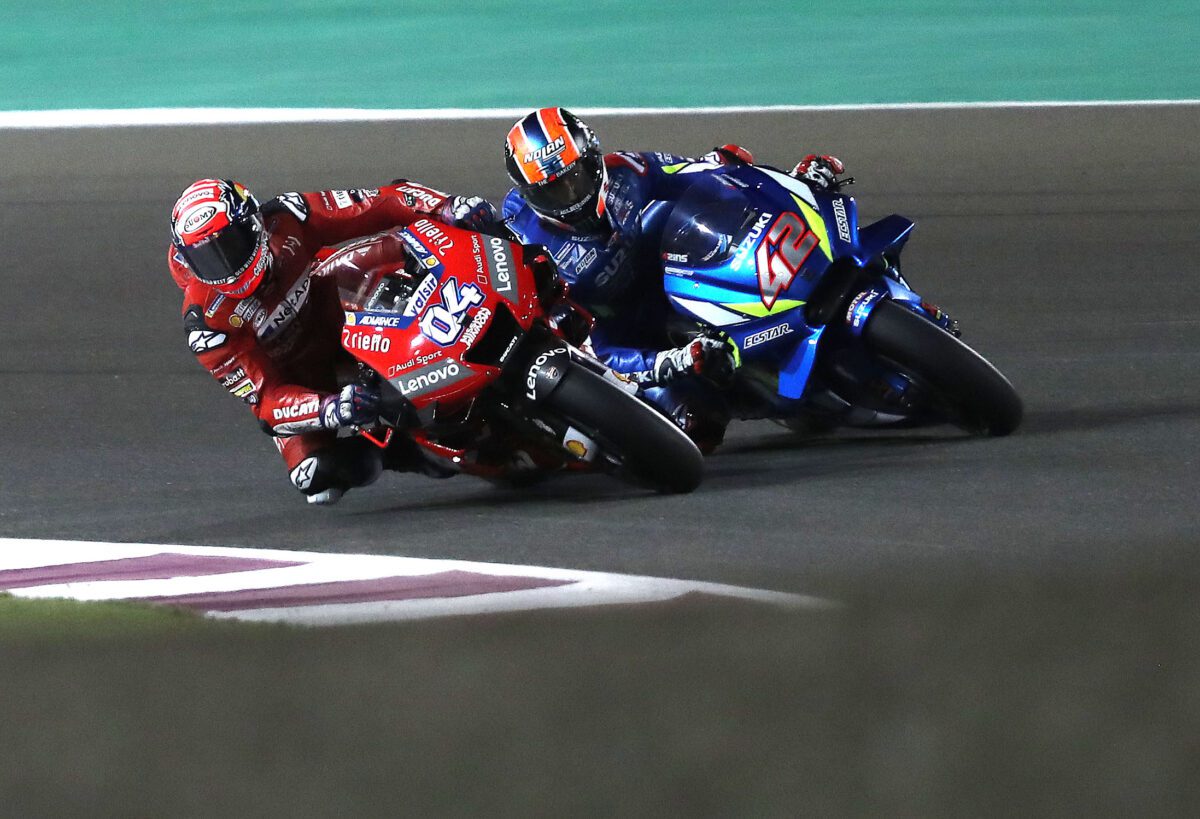
Another reason for the regression could be the change of the race start time from 21:00 local time to 20:00 local time, which happened in 2019 (2018’s race started at 19:00). The track temperature was actually cooler in 2019 (19C) than in 2016 (the last year of the 21:00 start time, at 23C), and the two 2021 races were cooler, too, both registering 22C. 2022 was warmer at 28C, which was matched in 2023 despite the different time of year, and the track temperature at this year’s race was recorded at 26C. Curiously, the 2015 race, which started at the same time as the 2016 race, recorded a track temperature of 28C, the same as 2022 and 2023.. Typically, MotoGP tyres need at least 20C of track temperature to operate in their optimum temperature window, so the low temperature in 2019 and the warmer temperatures in the races since then could also explain that 2018-2019 regression, as well as the progression in the following years.
Because, the route to the 2.6 per cent improvement Bagnaia has found over Rossi’s nine-year-old time has not happened in constant chunks over the last nine years. Instead, it happened a different way.
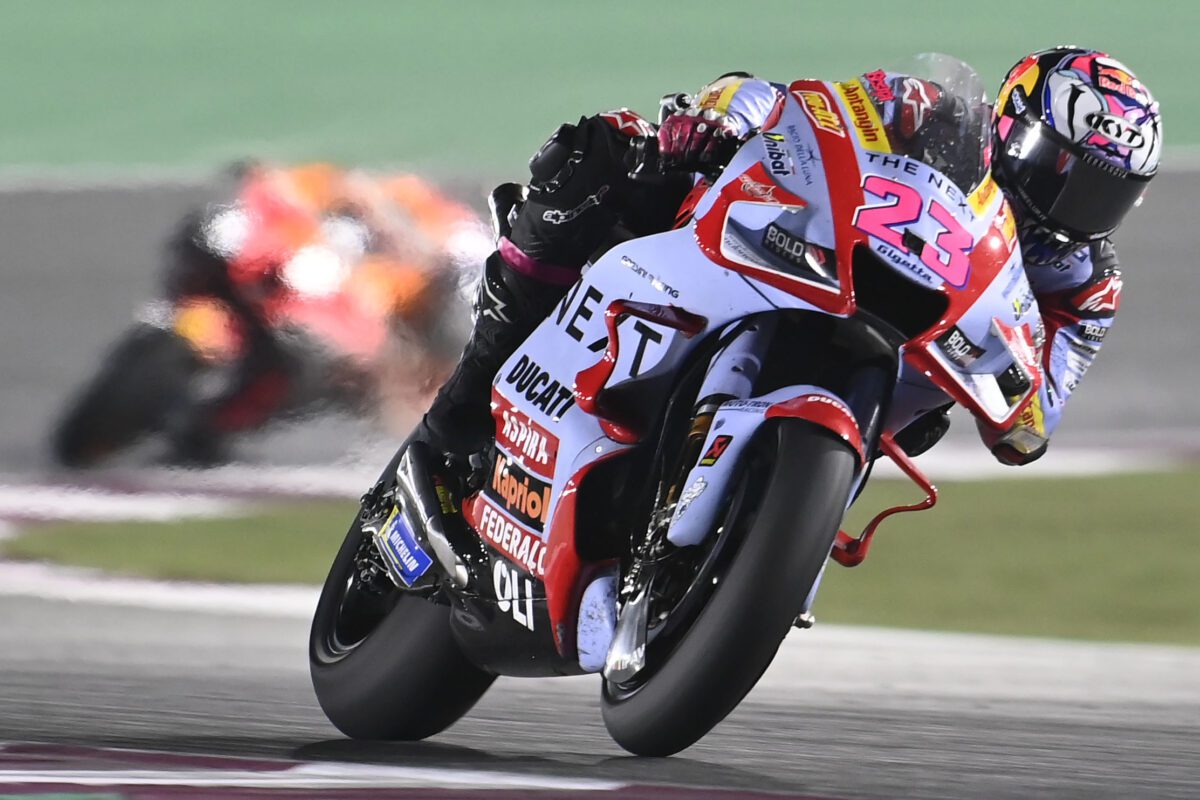
Mostly, it happened in two jumps - one much larger than the other. The first came when MotoGP returned to Lusail post-Covid in 2021, but was only confirmed in 2022, when Enea Bastianini won his first MotoGP race. The #23’s victory saw him reach the end of lap 21 in 40'17.317 - a 24-second, or 0.987 per cent, improvement over Dovizioso’s 2019 time, and a 15.312-second, or 0.629 per cent, improvement over Lorenzo’s 2016 time.

In 2021, when there was a three-day test and two Grands Prix at Lusail (or Losail as it then was), Maverick Vinales and Fabio Quartararo reached the end of lap 21 in 40:32.317 and 40:28.853 in the Qatar and Doha Grands Prix, respectively. That means that only in 2021, five years after Lorenzo won, was the #99’s time to lap 21 beaten, and Quartararo’s time in the second race, when the track was much more grippy than the first (or than in 2022, for that matter), was still 11.536 seconds slower than Bastianini’s 2022 time.

The second, and much larger, jump came in 2023, when Di Giannantonio was almost 30 seconds faster to lap 21 than Bastianini had been 20 months previously. Bagnaia’s time last Sunday was 42.448 seconds faster than Bastianini’s, meaning a 1.76 per cent improvement in two years.
Bastianini’s 2022 time was 0.944 per cent better than Rossi’s in 2015, meaning that MotoGP has evolved almost twice as much at Lusail between 2022 and 2024 than it did between 2015 and 2022.
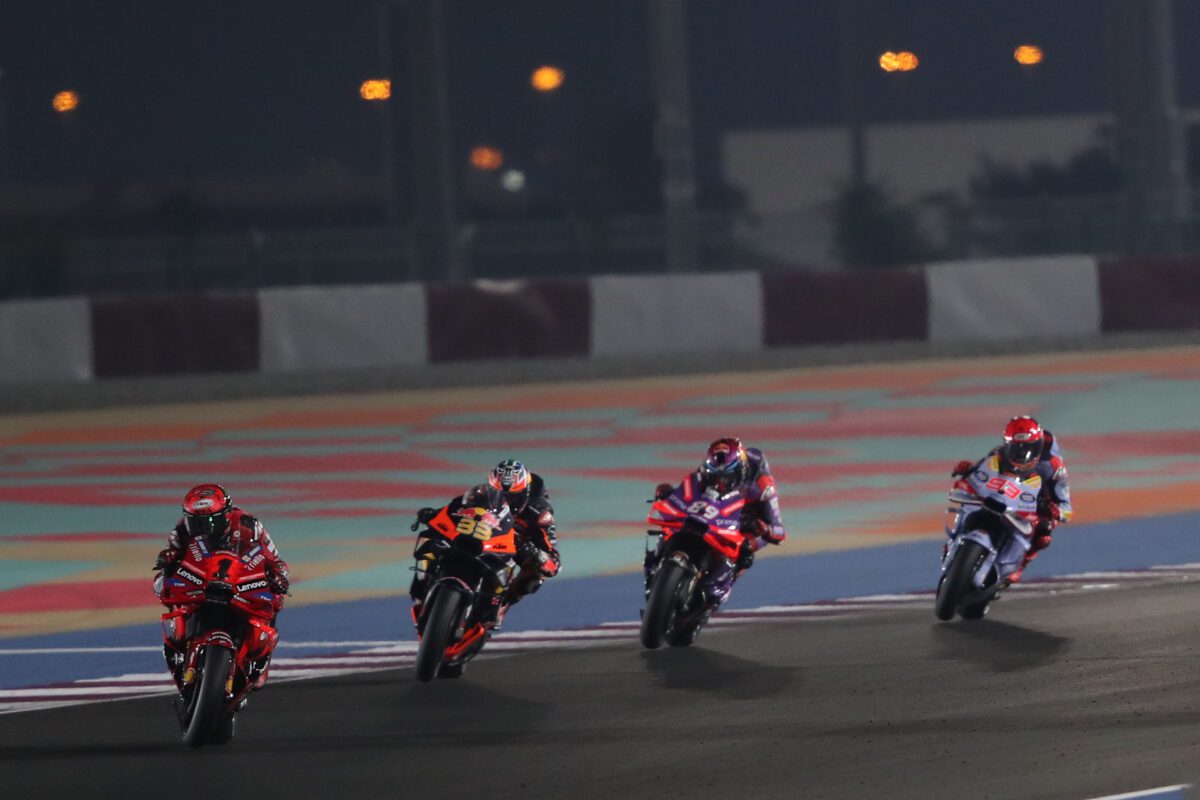
Why? Well, some will be down to motorcycle development, and some down to the new Michelin tyres that are harder and more durable, but which offer no less grip than the 2023 tyres. But a lot of it must be assumed to be down to the new track surface, which was laid last year along with the new ‘Misano 200’ kerbs, which have widened the racing surface in corners like turn nine and turn 16.
To further highlight the post-Covid performance jump, Andrea Dovizioso set pole position in 2015, when Ducati had concessions which allowed them softer tyre compounds than all of the other factory teams, at a 1:54.113. That wasn’t beaten until 2018, when Johann Zarco did a 1:53.680, and then Maverick Vinales set the 2019 pole at 1:53.546. Bagnaia set a 1:52.772 for pole in the first 2021 race (the first post-Covid race in Qatar, and the fist race with the softer tyres that Michelin debuted in 2020), a time which wasn’t beaten until Luca Marini went over one second faster with a 1:51.762 last year. This year, pole was another second faster (almost): a 1:50.789 by Jorge Martin, whose previous Qatar poles had come with low-1:53s in the second 2021 race and the 2022 GP. That’s a 2.913 per cent improvement over nine years, and 2.416 per cent of that was done post-Covid. Further, 1.175 per cent improvement was found over 2015 by Bagnaia’s 2021 pole time, meaning that 1.738 per cent of the pole position improvement has been found since the new surface was laid last year.

In 2024, Bagnaia’s slowest lap (other than the first lap) came on the final lap - 1:53.327 - while his average time (including the first lap) was 1:53.089, both of which which are faster than the fastest lap of every Grand Prix held at LIC, with the exception of 2023 - 1:52.978 by Bastianini (which was 1.360 seconds faster than his 2022 fastest lap) - and 2024 - 1:52.657 by Pedro Acosta. In fact, that average time by Bagnaia would have put him on pole in the 2021 Doha Grand Prix, and second on the grid in 2022.

Speaking of Acosta, he is not the first rookie to rip at Lusail. Johann Zarco led the first half-dozen laps in 2017 on his debut (for Tech3, like Acosta) before crashing at turn two, and Fabio Quartararo set the fastest lap of the race in his 2019 debut. Acosta’s best lap, though, was 2.382 seconds faster than that of Quartararo five years ago.
While the track surface has certainly played its role in the jump in lap time between 2022 and 2023, the previous jump, which materialised in 2022, is centred in the motorcycles and the tyres. As mentioned above, the race lap times hadn’t really moved on all that much in 2019 compared to four years before, but after 2020 the gains became more significant.

One reason for the Covid-era performance gains was the new rear tyre construction that Michelin brought in 2020, which was softer than had been used since the middle of 2016. It therefore increased grip and ultimate performance. A second reason could be the aforementioned race start time change and track temperatures.

Ironically, a third reason for the performance gains from the Covid period onwards is a development freeze. The pandemic led MotoGP to ban engine development during 2020 and 2021, which meant factories had to find other ways to improve their respective performance. That led Ducati to invest heavily in aerodynamic development and ride height devices, a path down which they were soon followed by the other factories at their own, respective paces.
The reason these areas have offered, and are offering, such large gains is because the technology remains quite new in MotoGP. Factories only started introducing downforce nine years ago, and the first ground effect experiments only began three years ago.

Such a short history of downforce aerodynamics in MotoGP means that there is still a lot of potential to be discovered, and probably in areas that have not yet been considered. It means that gains like we’ve seen in Qatar since 2021, and from last year to this, could still be possible, year-to-year, going forwards.
The 2027 regulation change will doubtless try to restrict aerodynamic development, but restricting wind tunnel time is practically pointless because most aerodynamic work is done on a computer. And, as for trying to ‘ban’ aerodynamics? Impossible, because any surface which touches the air - from the front wing to the rear-mounted camera, and from the front brake calliper to the rider themselves - is effectively an aerodynamic device, because it changes the flow of the air it meets; it changes its speed, and changes its direction.
It’s ultimately impossible to tell exactly how much faster MotoGP is now than last year, or any other year for that matter, simply because there have only been two tests and one race, and all of those have taken place on big, wide circuits which have been recently resurfaced and therefore offer a lot of grip. We will know a little more in this regard at Portimao, but especially once the main European season kicks off at the Spanish Grand Prix at the end of April.


![Shane Byrne, Monstermob Ducati, 2003 WorldSBK, action [Gold & Goose]](https://bikesportnews.com/wp-content/uploads/2025/07/Shane-Byrne-Monstermob-Ducati-2003-WorldSBK-action-Gold-Goose-480x272.jpg)
